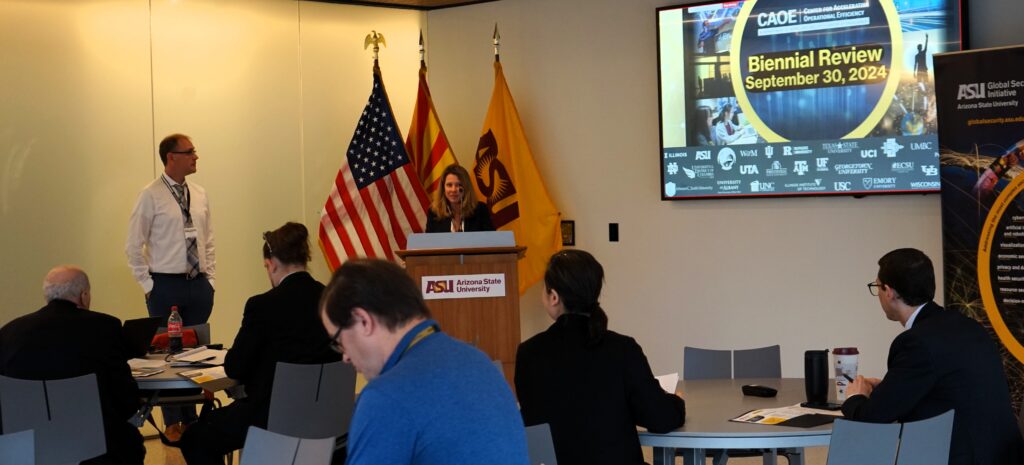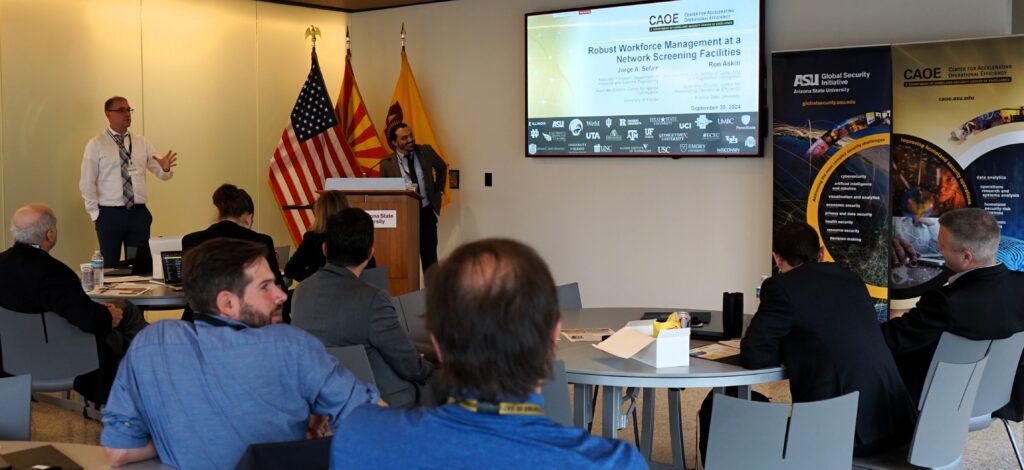
The CAOE Biennial Review serves as a critical platform for showcasing the latest research and innovations developed by the Center for Accelerating Operational Efficiency (CAOE), a Department of Homeland Security Center of Excellence. Held every two years, the event brings together Department of Homeland Security (DHS) stakeholders so researchers may present project updates to DHS stakeholders. In addition to showcasing projects on privacy-preserving technologies, artificial intelligence (AI), and critical infrastructure resilience, researchers shared significant advancements in their homeland security-related work, actively engaging with questions and gathering valuable feedback.
The event underscores the collaborative effort between academia and government, fostering an exchange of ideas that aims to bridge the gap between cutting-edge research and practical implementation. The review offers a space for researchers to highlight their progress, address current homeland security challenges, and receive feedback on their projects. This year’s review also serves as a key decision-making juncture, where stakeholders assess the continuation and future direction of research initiatives based on their potential impact on the homeland security enterprise.
As Ross Maciejewski, Director of CAOE, mentioned in his opening remarks, the center’s mission is to accelerate operational efficiency across the homeland security landscape by integrating advanced technologies, human factors, and data-driven solutions. The review not only highlights research outcomes but also opens the floor for discussions on transitioning technologies from research labs to real-world applications, ensuring that the DHS can effectively respond to evolving threats and operational challenges.

Bridging Privacy and Innovation
One of the focal points of the event was the exploration of new methodologies in privacy-preserving data analytics. Dr. Jia Zou, an assistant professor at Arizona State University, presented her work on the Synthetic IDNet Dataset for Privacy-Preserving Fraud Identity Document Detection. Zou’s project addresses the challenge of creating large-scale synthetic datasets to improve fraud detection without compromising individual privacy. “We need solutions that protect sensitive information while still enabling critical fraud detection efforts,” Zou explained.
Zou’s research includes a federated query optimizer, a tool designed to enhance privacy during data analysis, crucial for handling identity documents within the highly regulated environment of homeland security. Her team developed a synthetic benchmark dataset with nearly 600,000 identity documents, introducing innovative techniques like differential privacy and federated learning to prevent data exposure.
Tackling Non-IID Data in Federated Learning
Another highlight came from Dr. Jingrui He of the University of Illinois at Urbana-Champaign, who addressed the unique challenges posed by non-IID (non-independent and identically distributed) data in federated learning. He’s research, Privacy-Preserving Analytics for Non-IID Data, aims to facilitate secure collaboration among entities holding sensitive datasets. “In many real-world applications, data isn’t as neatly structured as we assume it to be, especially in security contexts where privacy risks are high,” said He. Her work introduces advanced deep learning techniques to handle these complexities, paving the way for more secure and efficient analytics without merging actual datasets.


Advancements in Secure Computations
Dr. Taeho Jung from the University of Notre Dame presented Guarding Sensitive Data with Trigeneous Secure Computations, a project leveraging cutting-edge cryptography techniques. Jung’s research combines fully homomorphic encryption with hardware-based security to allow secure and fast querying of sensitive data from various sources. This advancement is seen as critical in balancing the need for homeland security professionals to access vital information without compromising individual privacy. “Our approach makes it possible to work with encrypted data in a more flexible and efficient manner,” Jung said, adding that the project has already shown promising results in controlled environments.
Integrating Human and Artificial Intelligence
The integration of human intelligence with AI was discussed by Dr. L. Jean Camp from Indiana University, who showcased her project, Combining Human Intelligence with Artificial Intelligence for a Usable, Adaptable SBOM (CHIAUS). Camp’s interdisciplinary work explores how AI can assist in the communication of complex vulnerabilities within the software supply chain. Her approach combines human-centered design with emerging AI standards to enhance decision-making processes. “By bridging the gap between human understanding and machine-generated insights, we can create more reliable, secure software systems,” Camp remarked.

Resilience in Critical Infrastructure

The Biennial event also featured a session on Modeling the Impact of Complex, Multi-Vector Disruptions to the Marine Transportation System (MCAT), presented by Dr. Fred Roberts of Rutgers University. This project addresses how overlapping disruptions—such as cyberattacks, environmental challenges, and geopolitical conflicts—can severely impact maritime supply chains. Roberts’ work involves developing tools to help agencies like the U.S. Coast Guard better understand and manage these risks. “Our goal is to improve preparedness for compound disruptions, which are becoming increasingly problematic,” Roberts noted, highlighting recent real-world examples that have tested the resilience of global supply chains.

Resilience Engineering for Visual Screening in Security Settings (REVS)
Led by Dr. Mickey Mancenido from Arizona State University, this project focuses on the role of human operators in AI-enabled security screening systems. The research seeks to advance resilience engineering, a field that emphasizes how systems adapt to unpredictable events. Specifically, the team is examining human-AI interactions in automated face-matching biometrics and “explainable AI” baggage screening systems. By analyzing decision performance data, the project aims to identify unaccounted-for task environment factors that influence system resilience in high-security settings. The research will result in statistical models that explain meaningful human involvement in these systems and will generate new datasets for the broader research community, improving our understanding of human-AI collaboration in critical security tasks.
Dynamic Workforce Management at Network Screening Facilities
Dr. Jorge Sefair from the University of Florida leads this project, which addresses the growing pressures on TSA staff and resources due to rising air travel and increasing security threats. His team is developing advanced workforce management tools to optimize airport security screening operations. These tools will allow TSA planners to dynamically adjust checkpoint configurations, officer schedules, and workstation assignments to minimize passenger wait times and improve operational efficiency. By providing data-driven solutions and training, the project aims to help TSA adapt to changing workplace demands and enhance both security and the passenger experience through more efficient workforce utilization.

Future Directions and Center Management

During the event, Executive Director Dr. Ron Askin highlighted the CAOE’s commitment to the practical application of research through its transition portfolio. While he acknowledged that professors genuinely enjoy the research aspect—calling it “fun for us” because it stimulates their thinking and problem-solving abilities—he emphasized that the ultimate goal is to ensure these solutions are utilized. “It’s important not to overlook the transition phase,” Askin remarked, underscoring how CAOE bridges the gap between academic exploration and real-world implementation.
The review concluded with a discussion of CAOE’s strategic direction and center management, led by CAOE Director Dr. Ross Maciejewski. Maciejewski emphasized the importance of integrating research findings into actionable solutions for DHS and other stakeholders. “We are continuously evolving our approach to meet the demands of an ever-changing security landscape,” he said.
The event showcased the diversity and depth of research supported by CAOE, illustrating its critical role in advancing technologies that bolster the resilience and security of the nation. With ongoing collaborations among leading universities and government agencies, the center remains at the forefront of innovation in operational efficiency for homeland security.


